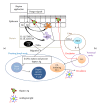Hapten-induced contact hypersensitivity, autoimmune reactions, and tumor regression: plausibility of mediating antitumor immunity
- PMID: 24949488
- PMCID: PMC4052058
- DOI: 10.1155/2014/175265
Hapten-induced contact hypersensitivity, autoimmune reactions, and tumor regression: plausibility of mediating antitumor immunity
Abstract
Haptens are small molecule irritants that bind to proteins and elicit an immune response. Haptens have been commonly used to study allergic contact dermatitis (ACD) using animal contact hypersensitivity (CHS) models. However, extensive research into contact hypersensitivity has offered a confusing and intriguing mechanism of allergic reactions occurring in the skin. The abilities of haptens to induce such reactions have been frequently utilized to study the mechanisms of inflammatory bowel disease (IBD) to induce autoimmune-like responses such as autoimmune hemolytic anemia and to elicit viral wart and tumor regression. Hapten-induced tumor regression has been studied since the mid-1900s and relies on four major concepts: (1) ex vivo haptenation, (2) in situ haptenation, (3) epifocal hapten application, and (4) antigen-hapten conjugate injection. Each of these approaches elicits unique responses in mice and humans. The present review attempts to provide a critical appraisal of the hapten-mediated tumor treatments and offers insights for future development of the field.
Figures



Similar articles
-
Dissection of antigenic and irritative effects of epicutaneously applied haptens in mice. Evidence that not the antigenic component but nonspecific proinflammatory effects of haptens determine the concentration-dependent elicitation of allergic contact dermatitis.J Clin Invest. 1996 Sep 1;98(5):1158-64. doi: 10.1172/JCI118899. J Clin Invest. 1996. PMID: 8787679 Free PMC article.
-
T cell immune responses to haptens. Structural models for allergic and autoimmune reactions.Toxicology. 1996 Feb 22;107(2):141-51. doi: 10.1016/0300-483x(95)03253-c. Toxicology. 1996. PMID: 8599173 Review.
-
Afferent and efferent phases of allergic contact dermatitis (ACD) can be induced after a single skin contact with haptens: evidence using a mouse model of primary ACD.J Invest Dermatol. 2003 Apr;120(4):641-7. doi: 10.1046/j.1523-1747.2003.12093.x. J Invest Dermatol. 2003. PMID: 12648229
-
Epicutaneous immunization with hapten-conjugated protein antigen alleviates contact sensitivity mediated by three different types of effector cells.Pharmacol Rep. 2012;64(4):919-26. doi: 10.1016/s1734-1140(12)70887-3. Pharmacol Rep. 2012. PMID: 23087144
-
Allergic contact dermatitis.Curr Dir Autoimmun. 2008;10:1-26. doi: 10.1159/000131410. Curr Dir Autoimmun. 2008. PMID: 18460878 Review.
Cited by
-
Management of Atopic Dermatitis Via Oral and Topical Administration of Herbs in Murine Model: A Systematic Review.Front Pharmacol. 2022 May 24;13:785782. doi: 10.3389/fphar.2022.785782. eCollection 2022. Front Pharmacol. 2022. PMID: 35685636 Free PMC article.
-
Trained Immunity Carried by Non-immune Cells.Front Microbiol. 2019 Jan 14;9:3225. doi: 10.3389/fmicb.2018.03225. eCollection 2018. Front Microbiol. 2019. PMID: 30692968 Free PMC article. Review.
-
Antibodies specific for nucleic acid modifications.RNA Biol. 2017 Sep 2;14(9):1089-1098. doi: 10.1080/15476286.2017.1295905. Epub 2017 Feb 23. RNA Biol. 2017. PMID: 28277931 Free PMC article. Review.
-
Tolerogenic Dendritic Cells for Regulatory T Cell Induction in Man.Front Immunol. 2015 Nov 9;6:569. doi: 10.3389/fimmu.2015.00569. eCollection 2015. Front Immunol. 2015. PMID: 26617604 Free PMC article. Review.
-
Establishment of a Quenchbody-based L-thyroxine detection method and its comparison with ELISA systems.Anal Bioanal Chem. 2024 Nov;416(28):6171-6180. doi: 10.1007/s00216-024-05558-5. Epub 2024 Sep 27. Anal Bioanal Chem. 2024. PMID: 39333299
References
-
- Kimber I, Basketter DA, Gerberick GF, Dearman RJ. Allergic contact dermatitis. International Immunopharmacology. 2002;2(2-3):201–211. - PubMed
-
- Honda T, Egawa G, Grabbe S, Kabashima K. Update of immune events in the murine contact hypersensitivity model: toward the understanding of allergic contact dermatitis. Journal of Investigative Dermatology. 2013;133(2):303–315. - PubMed
-
- Christensen AD, Haase C. Immunological mechanisms of contact hypersensitivity in mice. APMIS. 2012;120(1):1–27. - PubMed
Publication types
MeSH terms
Substances
LinkOut - more resources
Full Text Sources
Other Literature Sources

